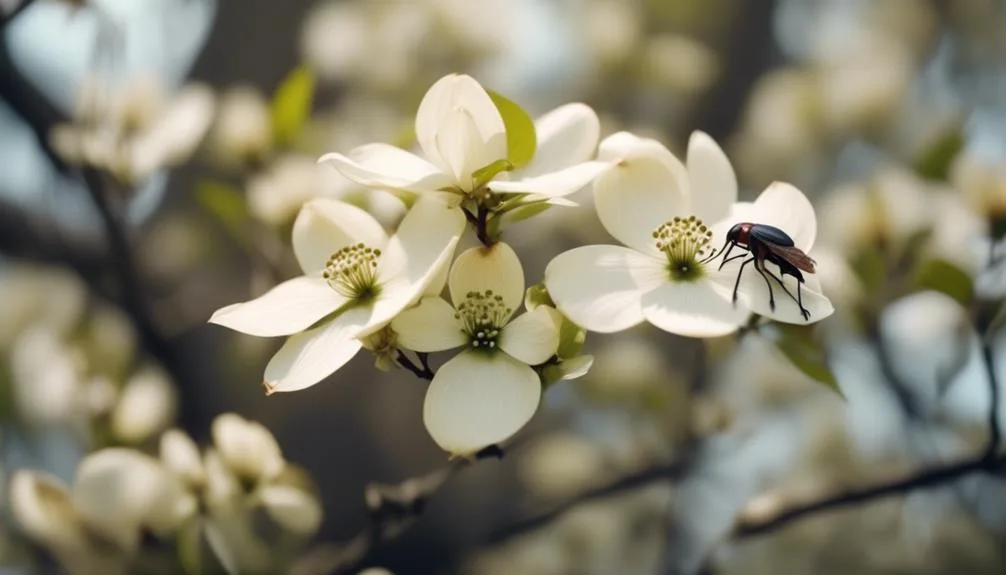Dogwood trees are more important than you might think for local wildlife. They provide food and shelter for many animals and contribute to the overall health of the ecosystem.
How exactly do they do this? Let's explore the ways in which dogwood trees help enrich the variety of life in their surroundings.
Dogwood Trees as Habitat Providers
Dogwood trees provide a vital habitat for a diverse array of wildlife, offering shelter, food, and nesting sites for various species in your local ecosystem.
The tree canopy of dogwood trees provides a safe haven for birds, squirrels, and insects. Their branches and foliage create a protective cover, shielding creatures from predators and the elements.
The dense network of branches and leaves also serves as ideal nesting sites for birds, providing a secure location for raising their young. Additionally, the vibrant flowers and abundant berries of dogwood trees attract pollinators and small mammals, contributing to the overall biodiversity of the area.
Role of Dogwood Trees in Supporting Wildlife
Nestled among the vibrant foliage of your local environment, dogwood trees actively support diverse wildlife by providing essential shelter, food, and nesting sites. These trees play a crucial role in the ecological balance, offering a wide array of benefits that enhance biodiversity. From providing a safe haven for nesting birds to offering nourishing berries for various animals, dogwood trees contribute significantly to the local wildlife support system. Here's a glimpse of how dogwood trees support wildlife:
| Ecological Benefits | Description |
|---|---|
| Shelter | Dense foliage and branching patterns provide safe havens for birds and small mammals. |
| Food | Berries attract birds, squirrels, and other wildlife, contributing to their diet. |
| Nesting Sites | The intricate structure of dogwood trees offers secure locations for birds to build their nests. |
| Wildlife Attraction | The vibrant flowers and berries of dogwood trees attract a diverse range of wildlife. |
| Habitat Diversity | Dogwood trees add to the variety of habitats available, supporting a wide range of species. |
Dogwood Trees and Pollinator Diversity
Amidst the lush surroundings of your local environment, dogwood trees play a vital role in fostering a diverse community of pollinators through their vibrant blossoms and nectar-rich flowers. These trees are essential for insect pollination, attracting a wide array of pollinators such as bees, butterflies, and flies.
Dogwood trees provide a crucial food source for these pollinators, aiding in their survival and contributing to the overall biodiversity of urban landscapes. Their presence supports the health and abundance of pollinator populations, which in turn benefits the surrounding ecosystem by facilitating the pollination of other plants.
In urban areas, where green spaces may be limited, dogwood trees serve as valuable hubs for pollinators, helping to maintain an essential balance within the local environment.
Dogwood Trees and Soil Health
Playing a vital role in nurturing a diverse community of pollinators, the presence of dogwood trees also has a significant impact on the health and vitality of the soil in their surrounding environment.
Dogwood trees contribute to soil fertility by their well-developed and extensive root systems. The roots of dogwood trees help to aerate the soil, allowing water and nutrients to penetrate deeply, which benefits not only the trees themselves but also the surrounding plant life.
Furthermore, the decaying leaves and roots of dogwood trees enrich the soil with organic matter, promoting microbial activity and enhancing nutrient availability for other plants.
As a result, the presence of dogwood trees not only beautifies the landscape but also plays a crucial role in maintaining healthy, fertile soil, which is fundamental for supporting diverse and thriving ecosystems.
Importance of Dogwood Trees in Ecosystem Balance
Dogwood trees contribute significantly to maintaining a balanced and thriving ecosystem through their role in supporting local biodiversity. Their presence helps to regulate ecosystem balance by providing crucial habitat and food sources for a diverse range of wildlife.
As a keystone species, dogwood trees play a vital role in promoting plant diversity within the ecosystem. This is essential for maintaining a healthy balance among different species, preventing the domination of any single plant type, and ensuring the stability of the entire ecosystem.
Conclusion
In a world where every living creature plays a vital role, the dogwood tree stands as a silent guardian of local biodiversity. Its contribution to wildlife habitat, soil health, and pollinator diversity is invaluable.
Let's cherish and safeguard these remarkable trees, for they're a cornerstone of our ecosystem's delicate balance, supporting the survival of countless species.

My interest in trees started when I first saw the giant sequoias in Yosemite.
I was a teenager then, and I remember thinking, “I need to learn more about this.”
That moment stuck with me.
A few years later, I went on to study forestry at Michigan Tech.
Since graduating, I’ve worked in a mix of hands-on tree care and community education.
I’ve spent over ten years helping people understand how to plant, maintain, and protect the trees in their neighborhoods.
I don’t see trees as just part of the landscape.
They are living things that make a real difference in our daily lives.
